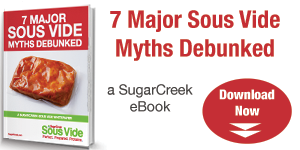 So you're a chef who has finally taken the plunge and purchased a sous vide system. The allure of juicy, tender meats, bursting with flavor, of being able to pre-cook and store vegetable dishes without having to worry about mushiness, and of having the ability to set a cook time and walk away for a few hours was undoubtedly strong.
So you're a chef who has finally taken the plunge and purchased a sous vide system. The allure of juicy, tender meats, bursting with flavor, of being able to pre-cook and store vegetable dishes without having to worry about mushiness, and of having the ability to set a cook time and walk away for a few hours was undoubtedly strong.
But now what? If you are new to sous vide preparation and sous vide food products, getting set up may seem intimidating. Today we thought it might be helpful to take you through some of the initial steps you should be taking to get up to speed and cooking efficiently.
How do I figure out cooking times and temps?
It's one of the first questions sous vide newbies often pose. Luckily, there are plenty of recipes and resources to help you online.
One of our favorite resources is a free, printable cooking temperature and time guide available from the good folks over at ChefSteps. Their guide breaks down the cooking temperature and recommended cooking times for a variety of meats and vegetables, including minimum time, maximum time and ChefSteps' recommended sweet-spot time.
Best of all, though, their guide is broken down by specific cuts and desired end temperature, so you won't be left guessing how to cook a rare filet mignon versus a medium well-flank steak. It includes helpful tips— like thickness suggestions and serving ideas— to help you acclimate to sous vide methods.
A more picturesque guide is available at Modernist Cooking Made Easy, if you are a visual learner. It features colorful photographs of fully cooked sous vide dishes, with easy to follow instructions, to help you develop a better feel for cooking and presentation.
Learn the what. Then dig in to the why.
Once you have the basics down, a more robust online guide is available from University of Colorado mathematician Douglas Baldwin, a sous vide enthusiast who has written a number of peer-reviewed food science articles, as well as his own cookbook, Sous Vide for the Home Cook.
Baldwin's guide isn't for the kitchen novice. It goes into fine detail about packaging techniques, food pathogens to watch out for (and best practices for eliminating them) and even has an extensive discussion section about the chemical mechanisms underlying the Maillard reaction. If you really want to learn about the science behind sous vide— which would, of course, help you to develop new dishes and innovate new techniques over the long-run— then this is the online resource for you.
Perhaps most helpful on Baldwin's site are the number of video cooking demonstrations— such as for salmon mi-cuit or sous vide crème brûlée— that he has included and with which visual or experiential learners can follow along while prepping in the kitchen.
Once you've mastered sous vide, start experimenting.
There's nothing better for a chef than getting into the kitchen with nothing but a few ingredients and a wild concept. One of the best aspects of sous vide cooking is that it is so flexible; the cooking method is very forgiving if you are a few minutes late in pulling a dish here and there, allowing you the freedom to experiment in the meantime with sauce prep, spice blending, or other side tasks.
You can even pre-cook a number of meat and vegetable bases and store them— with less worry about long-term storage and freezer burns, due to the vacuum packing technique— freeing you up to play around with finishing, seasoning, plating and presentation.
Food innovation can be tough if you are under the gun on short cook times, or limited in available storage space. Sous vide may be just the solution you've been looking for.







